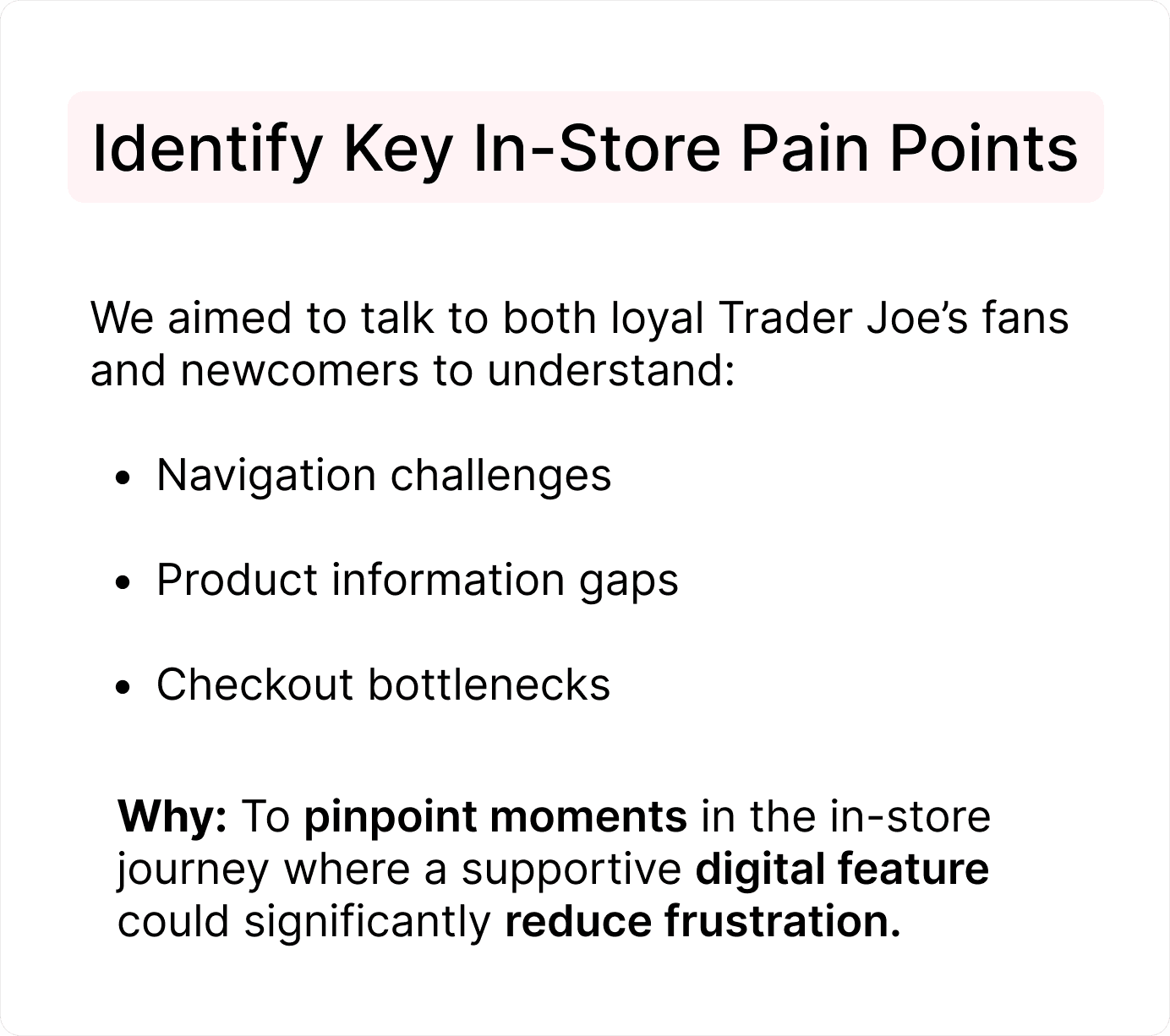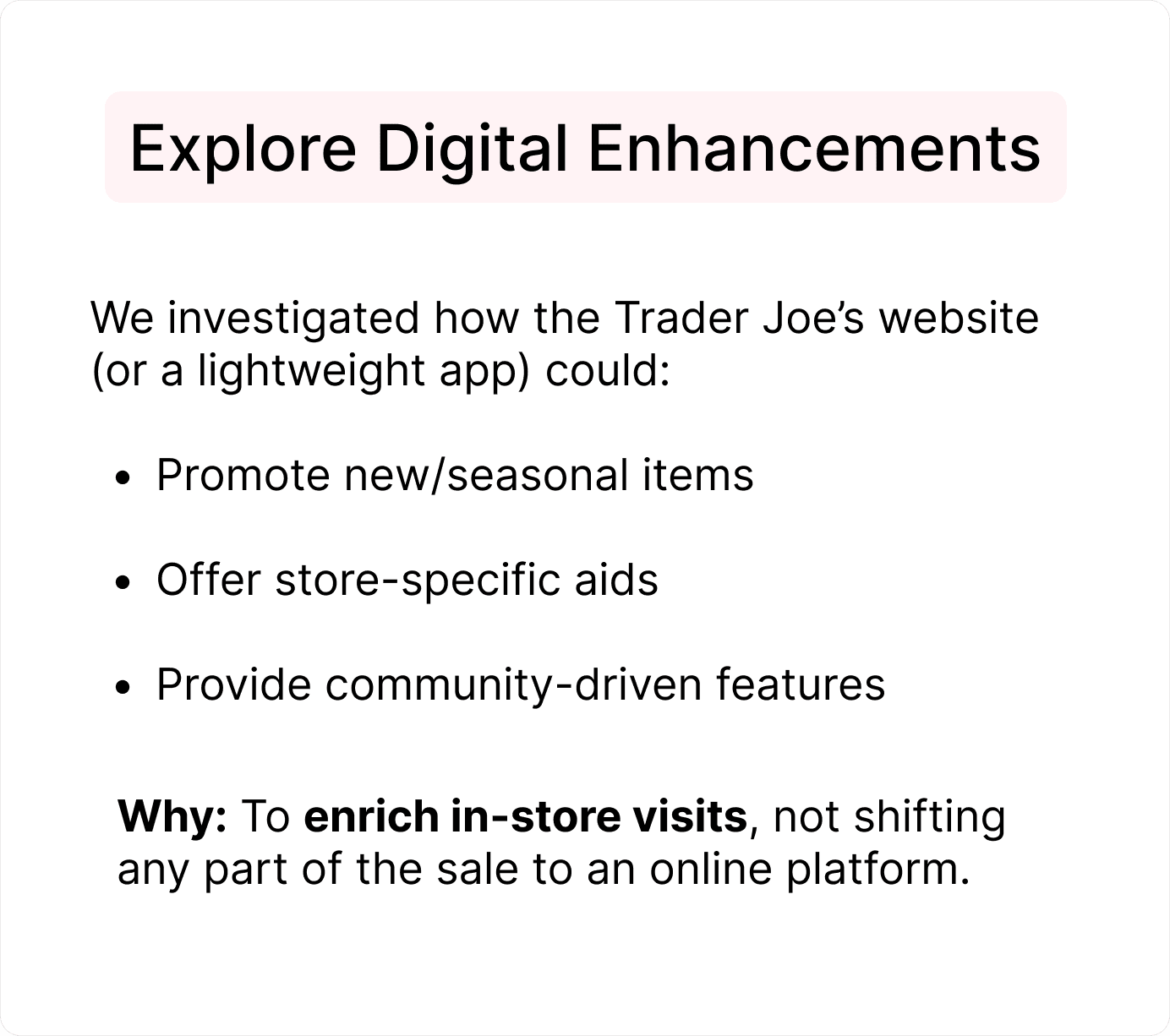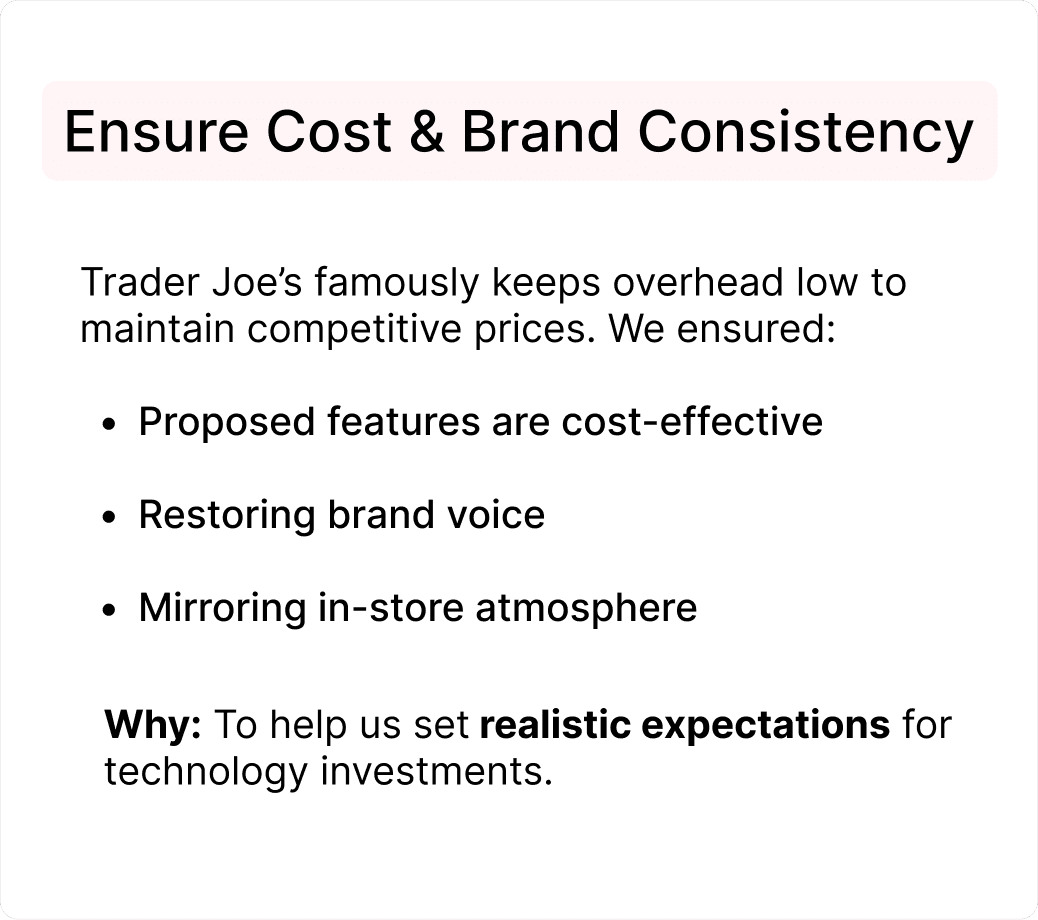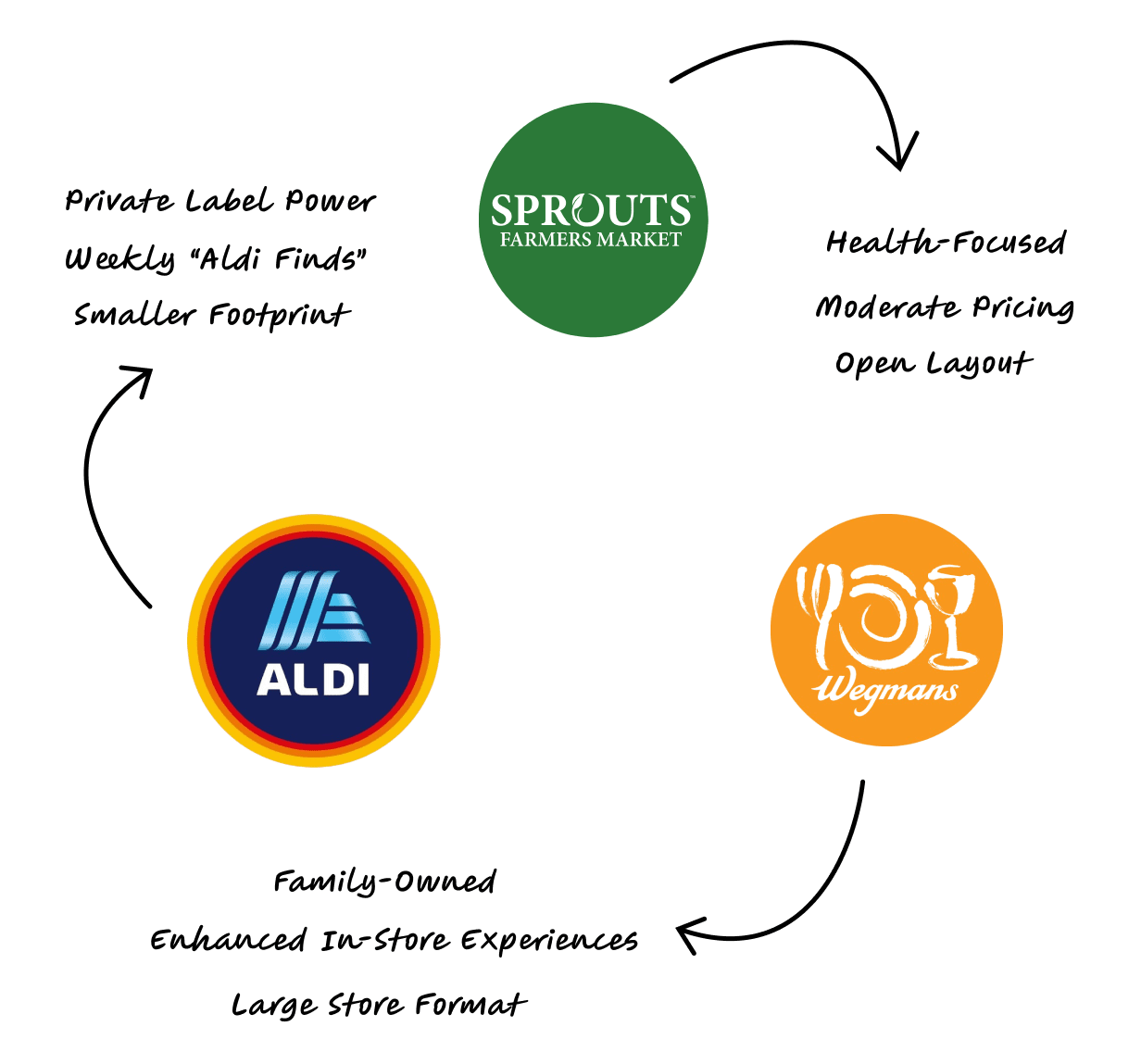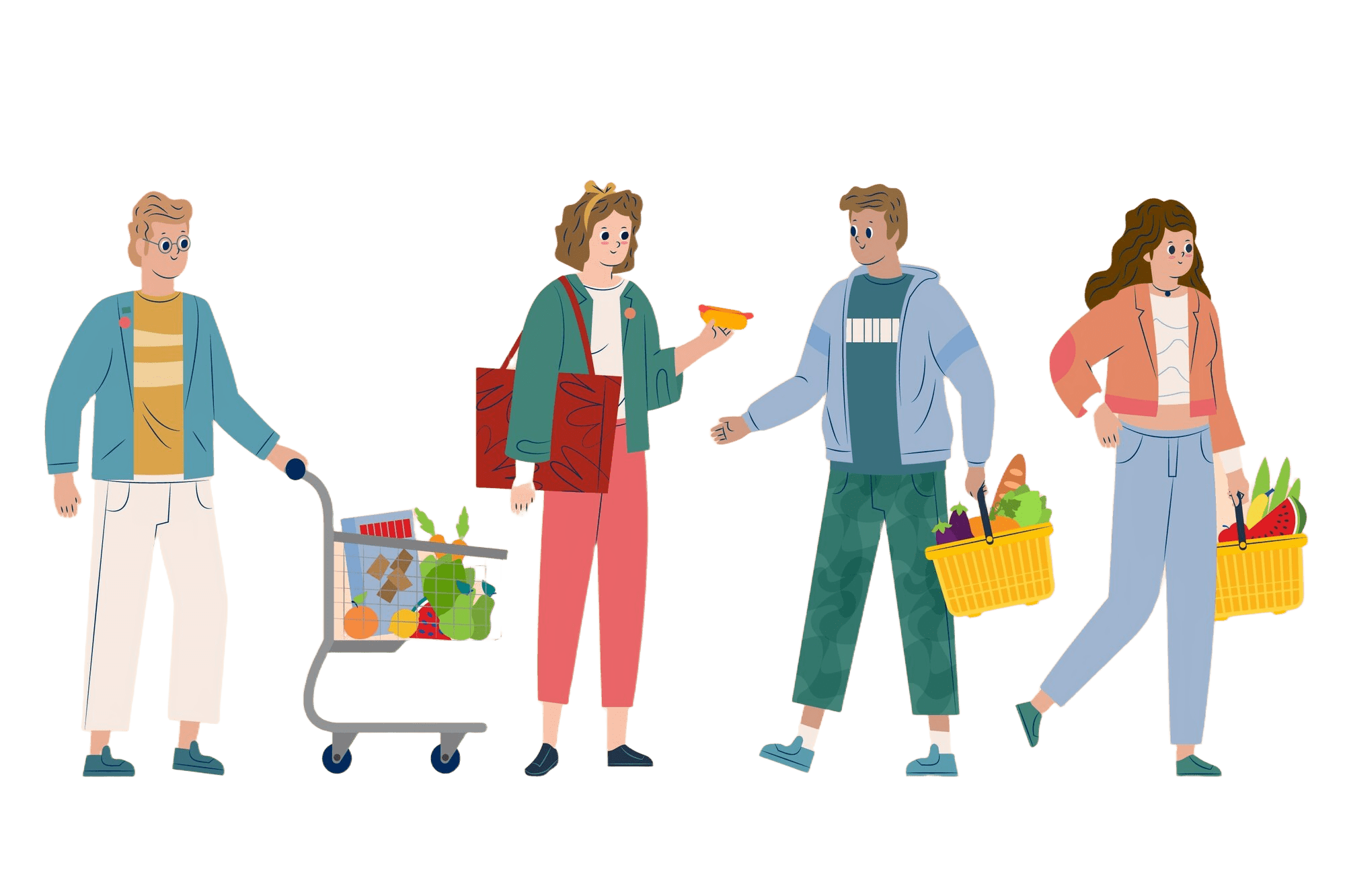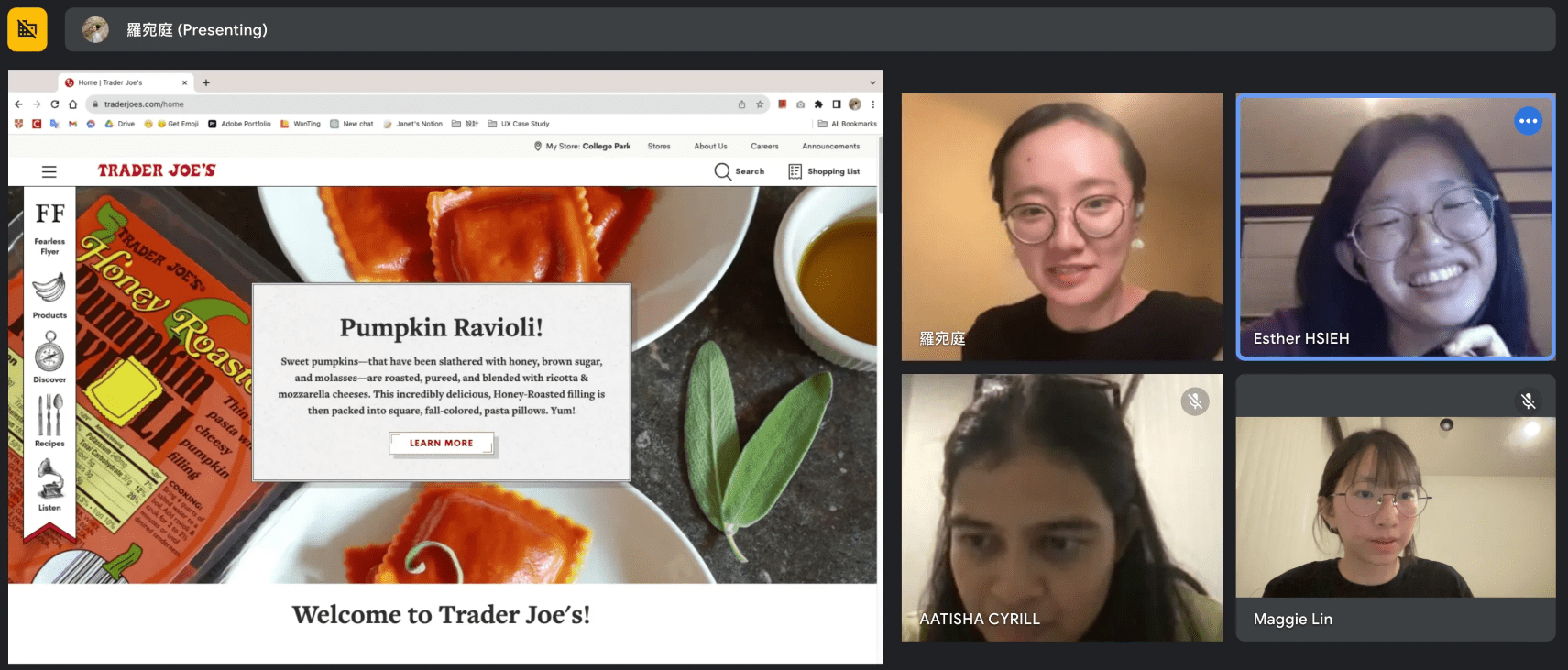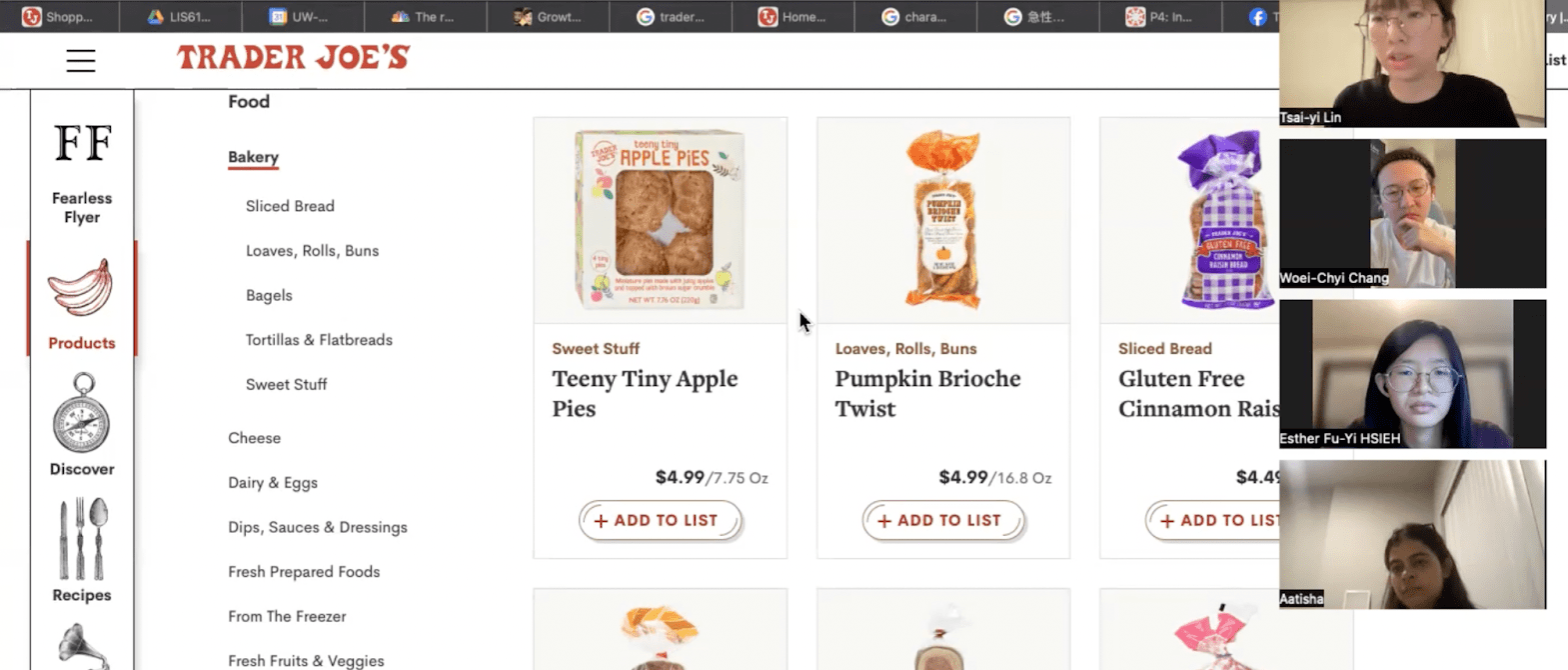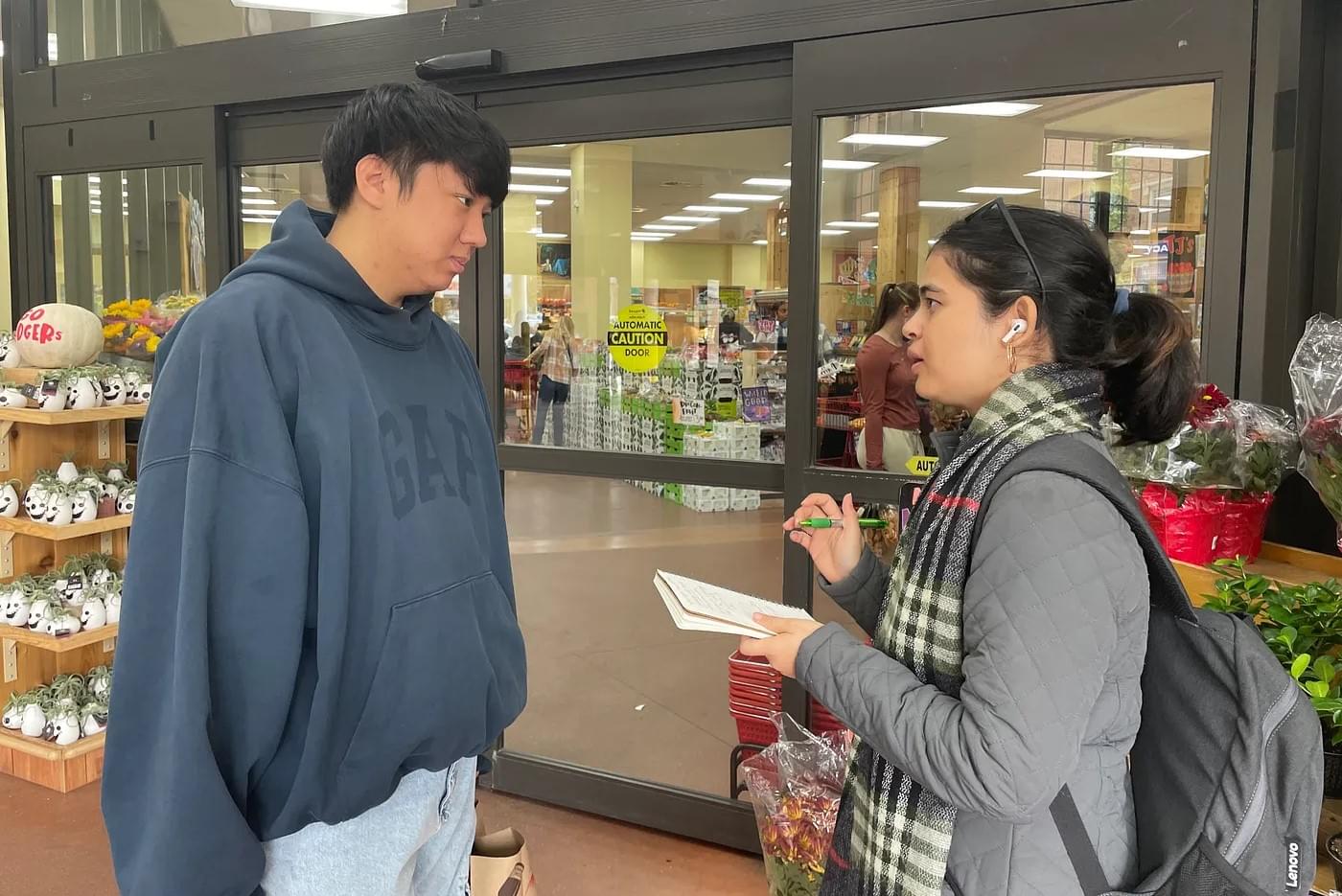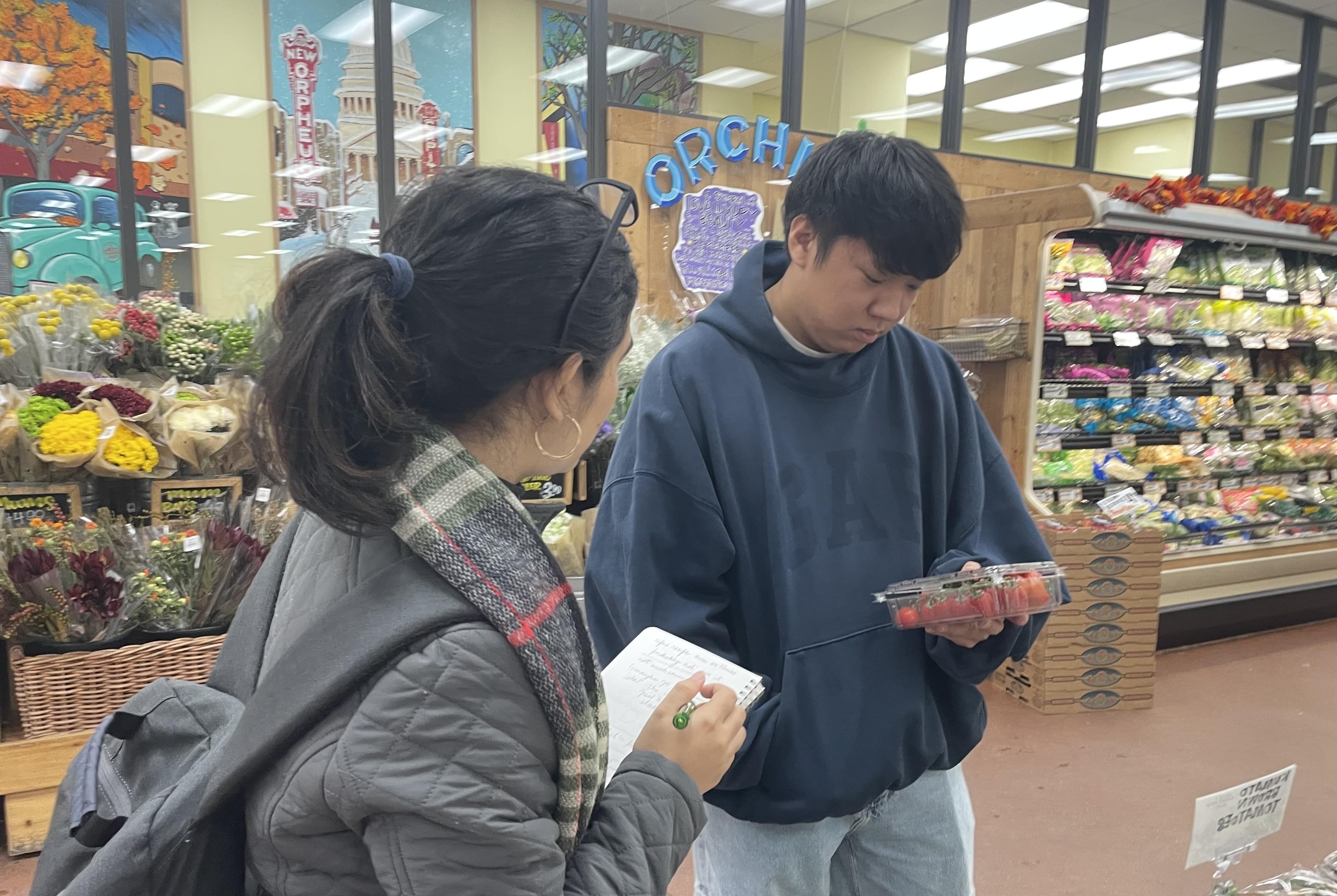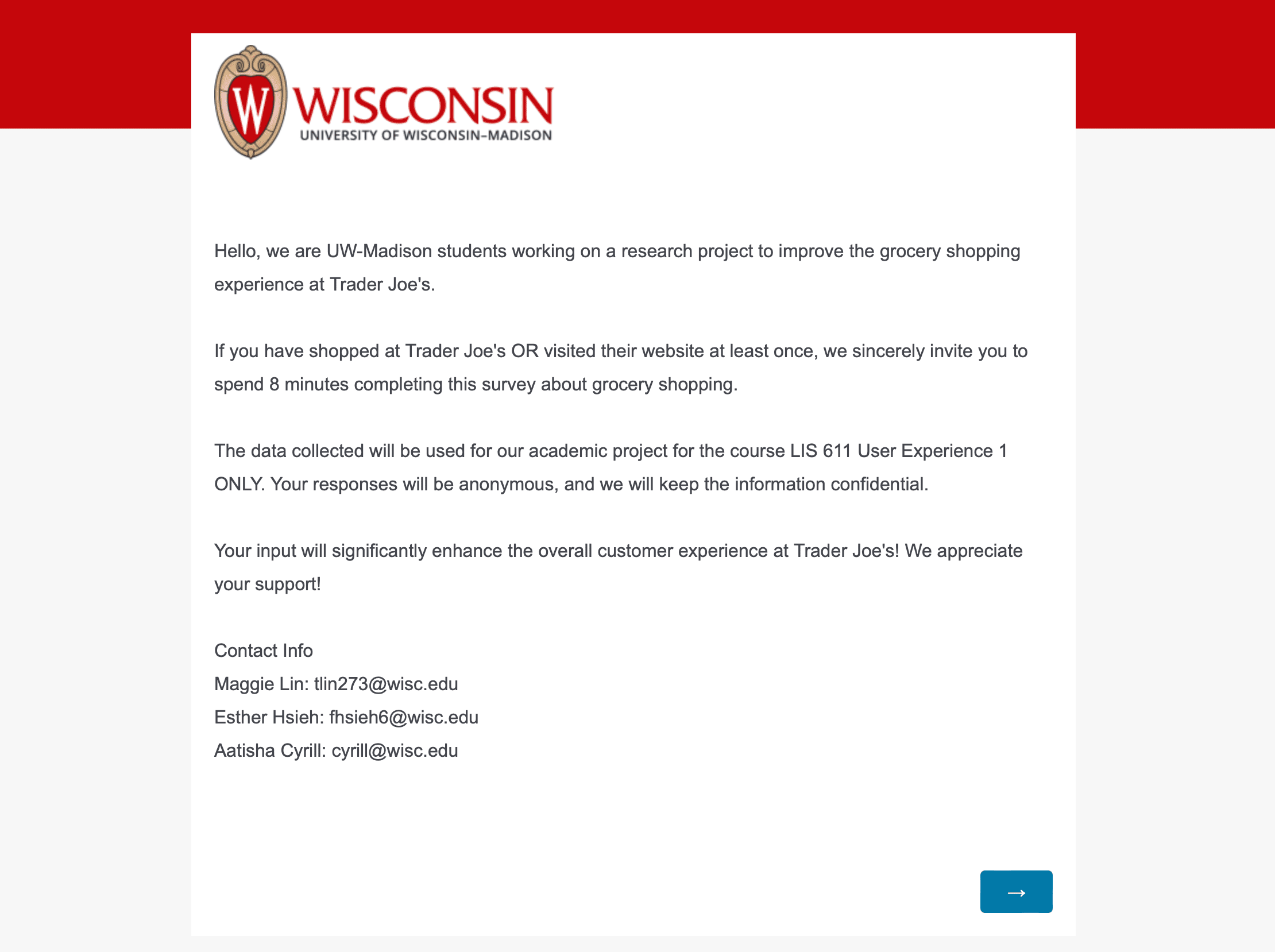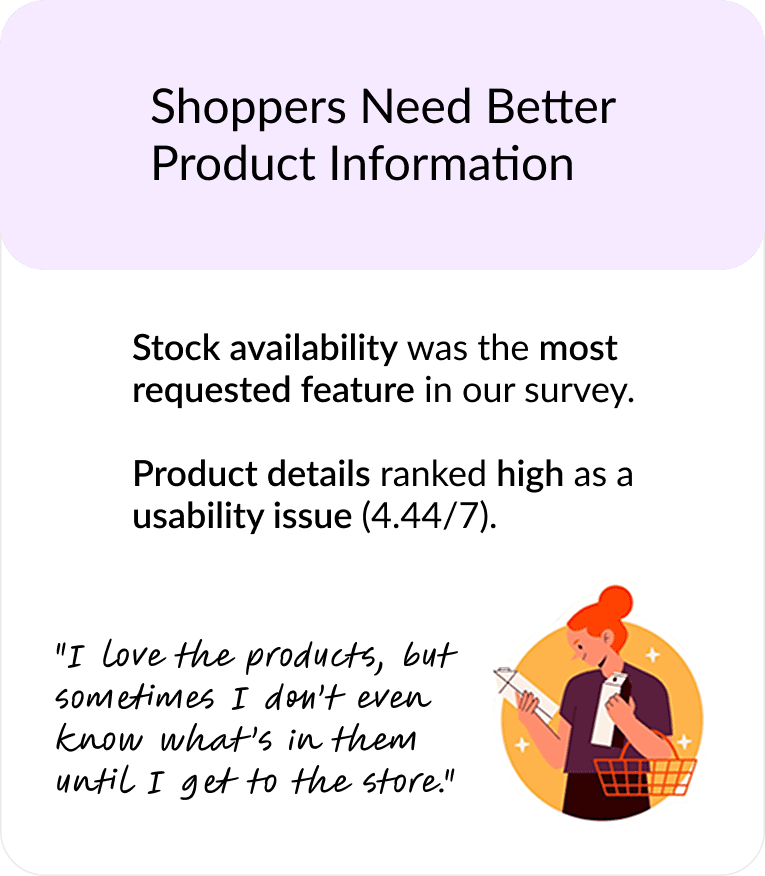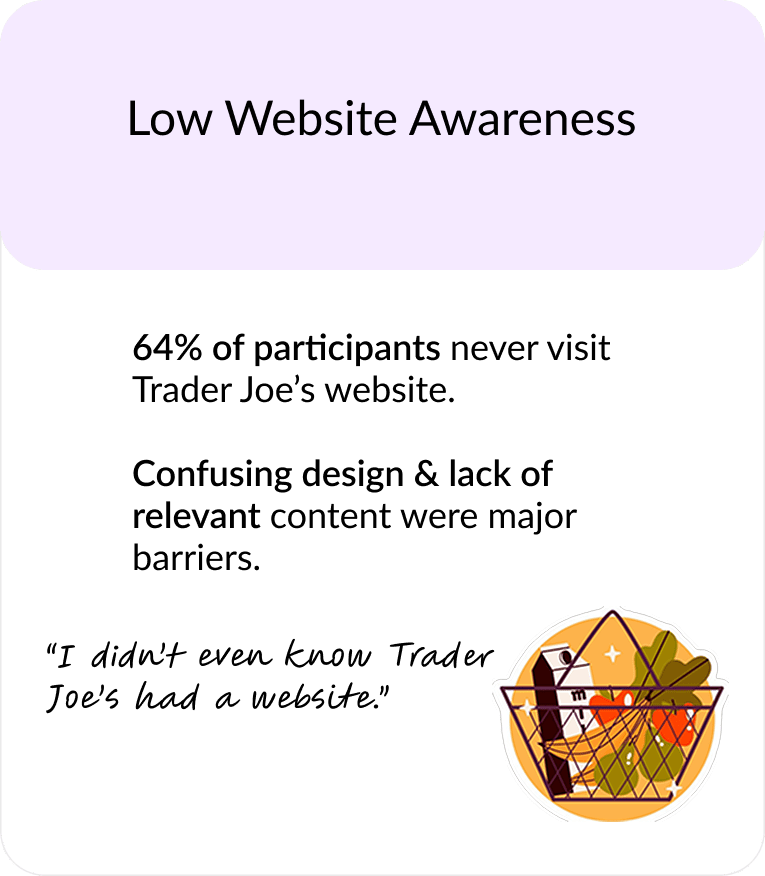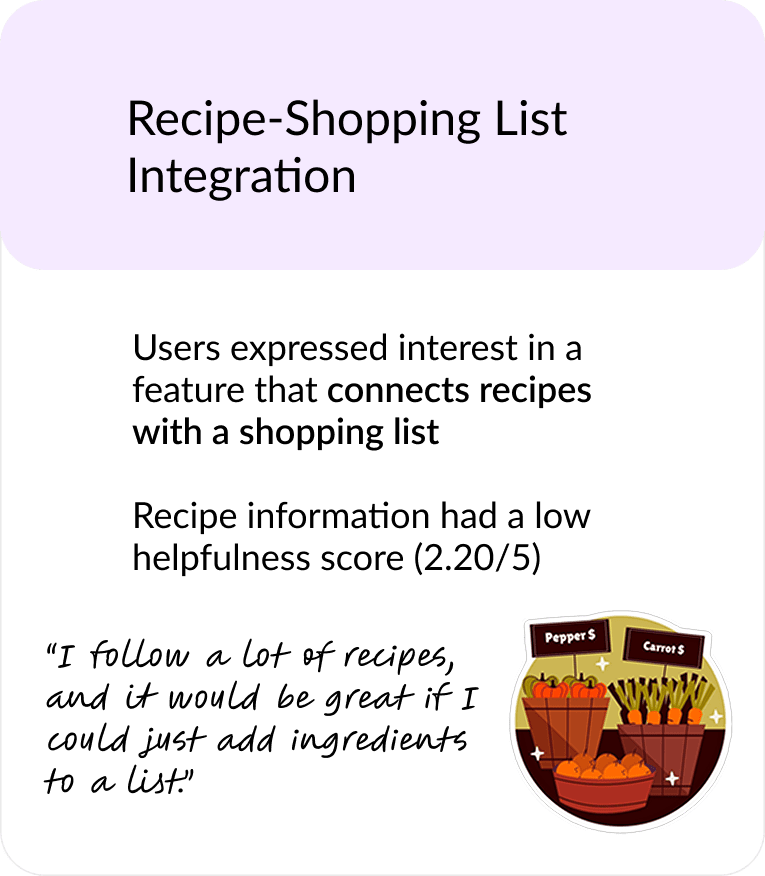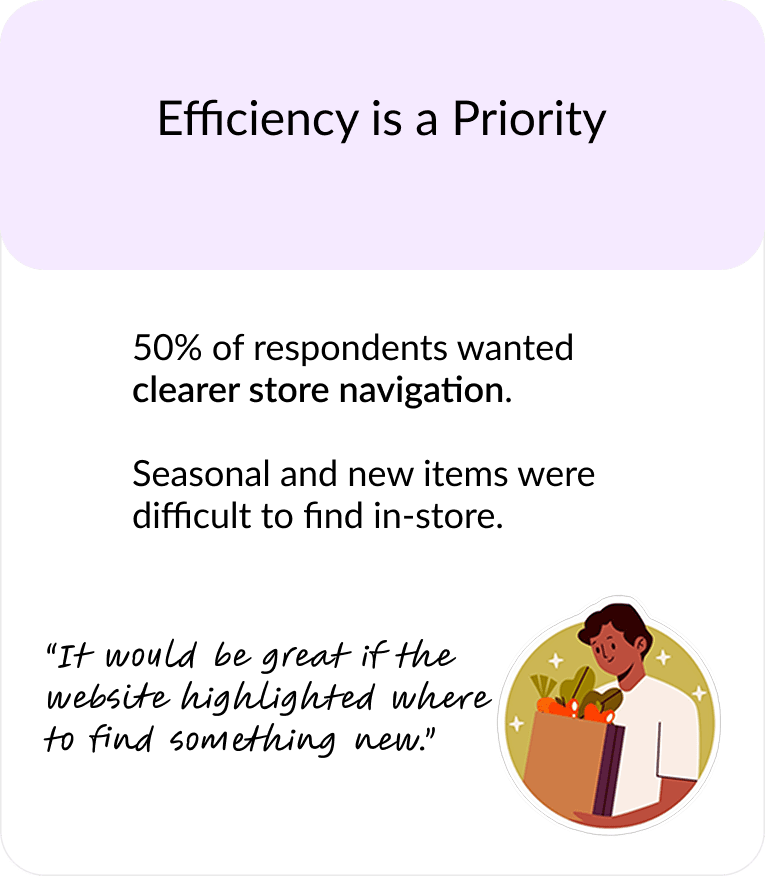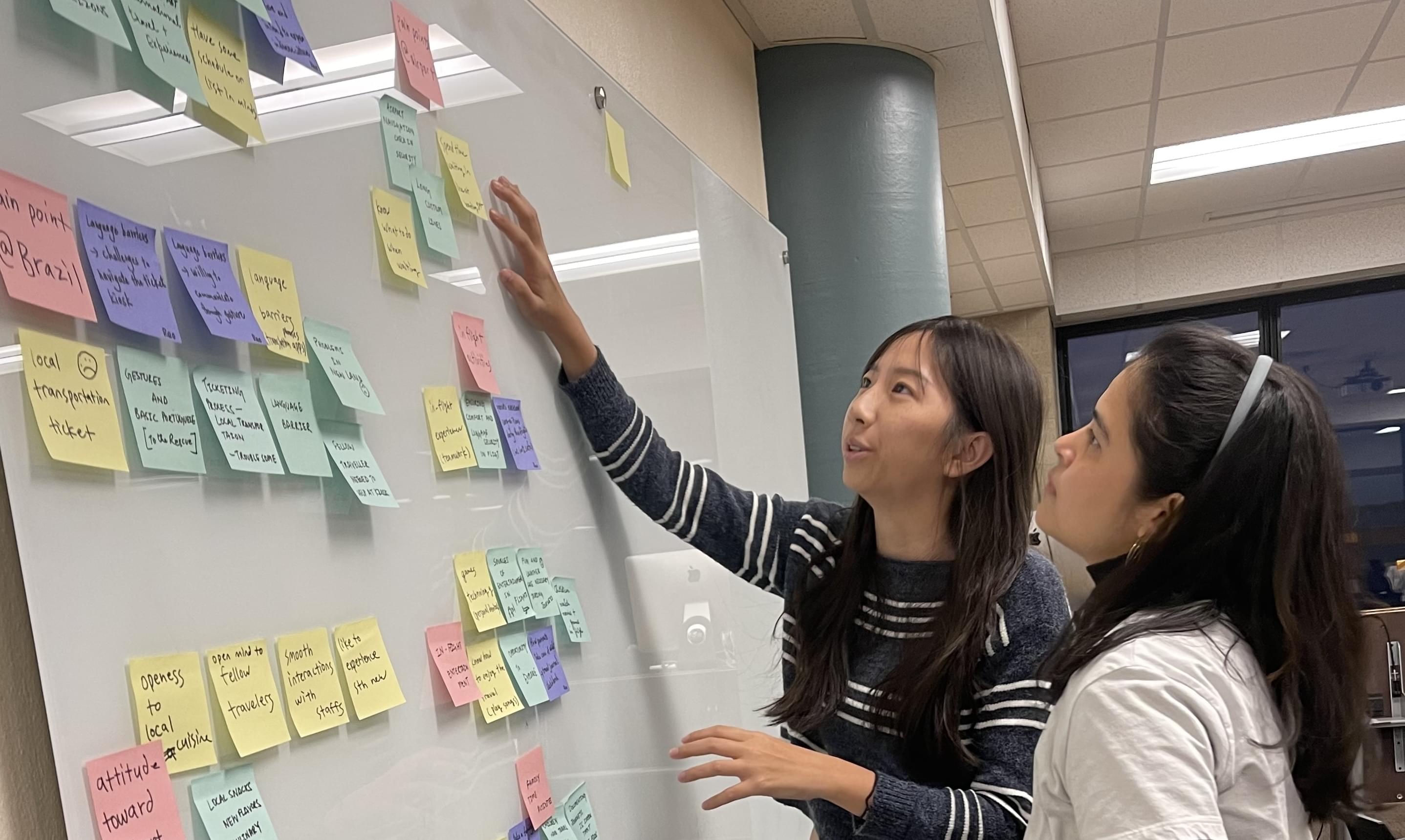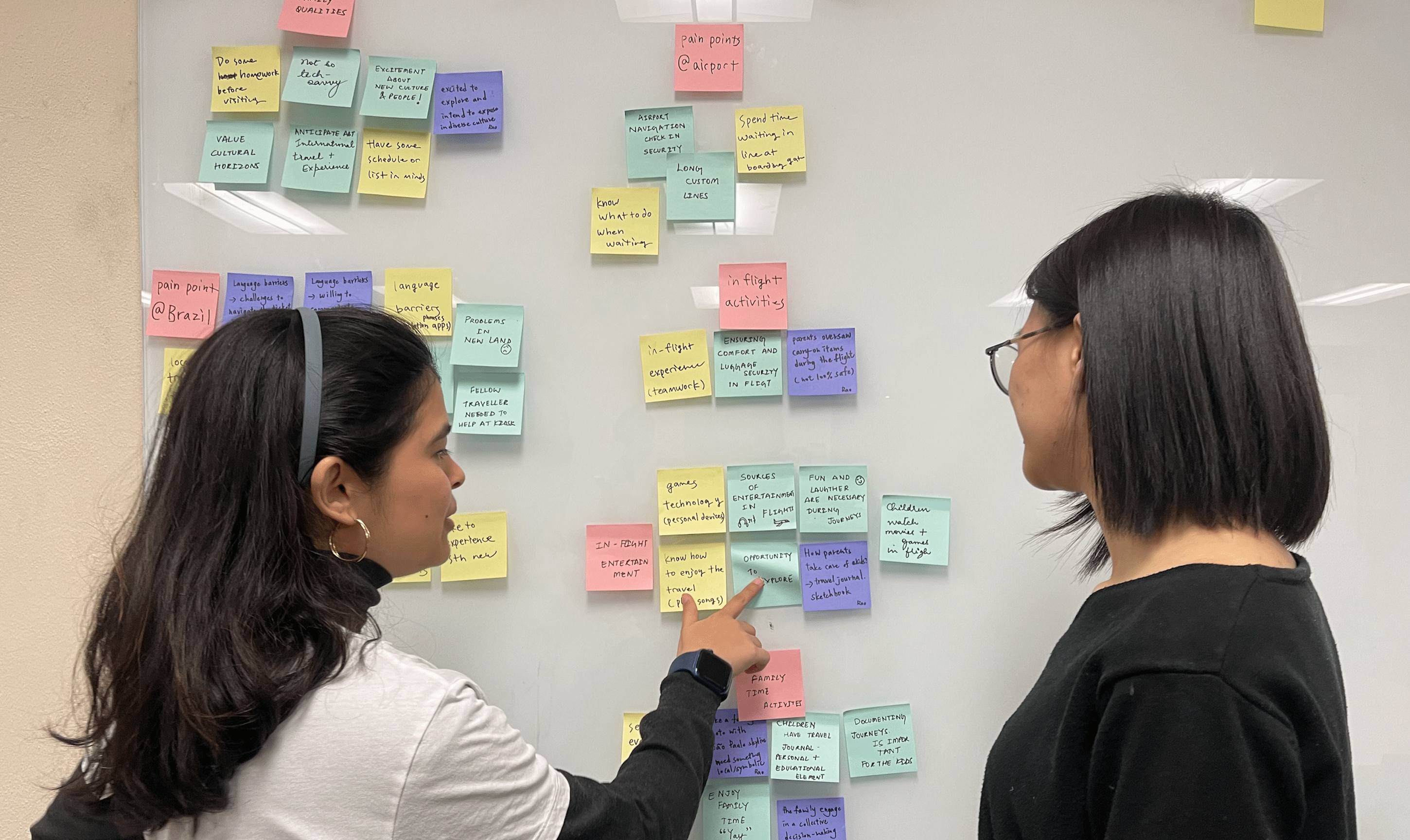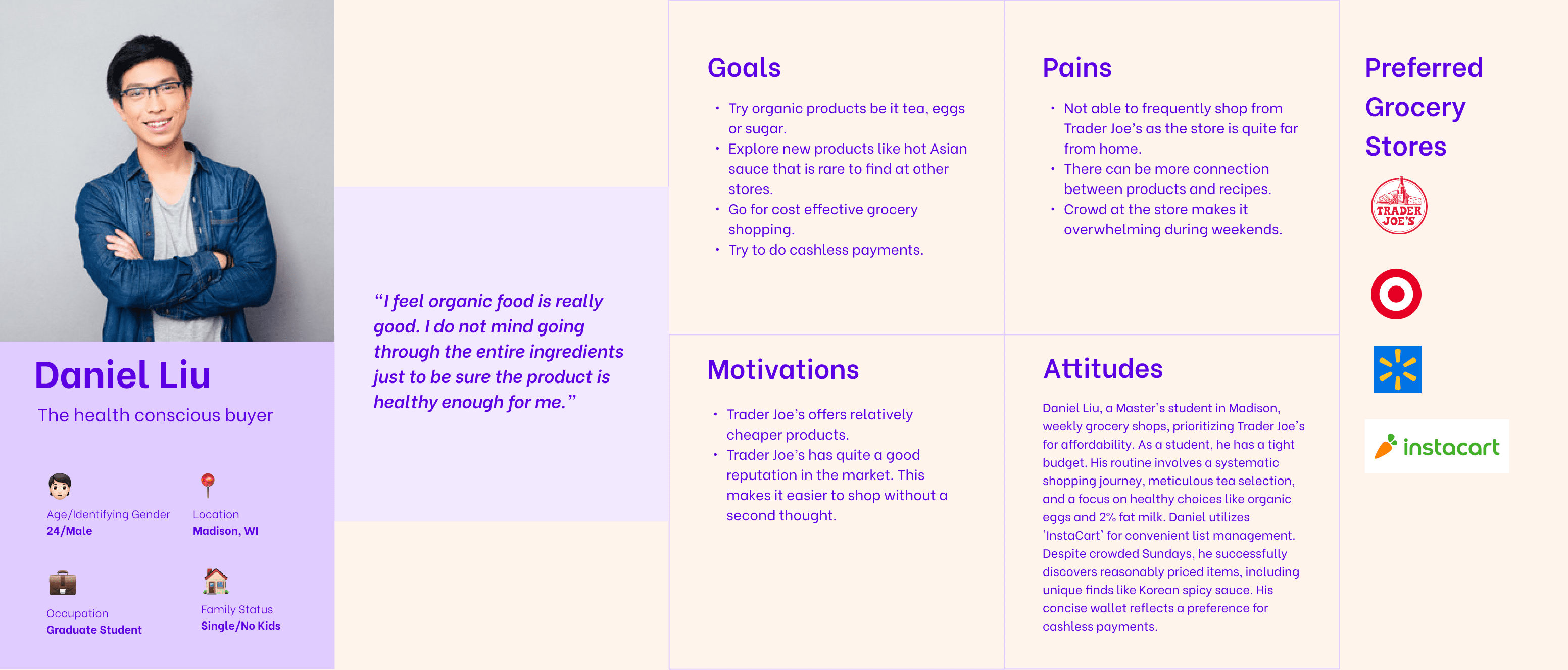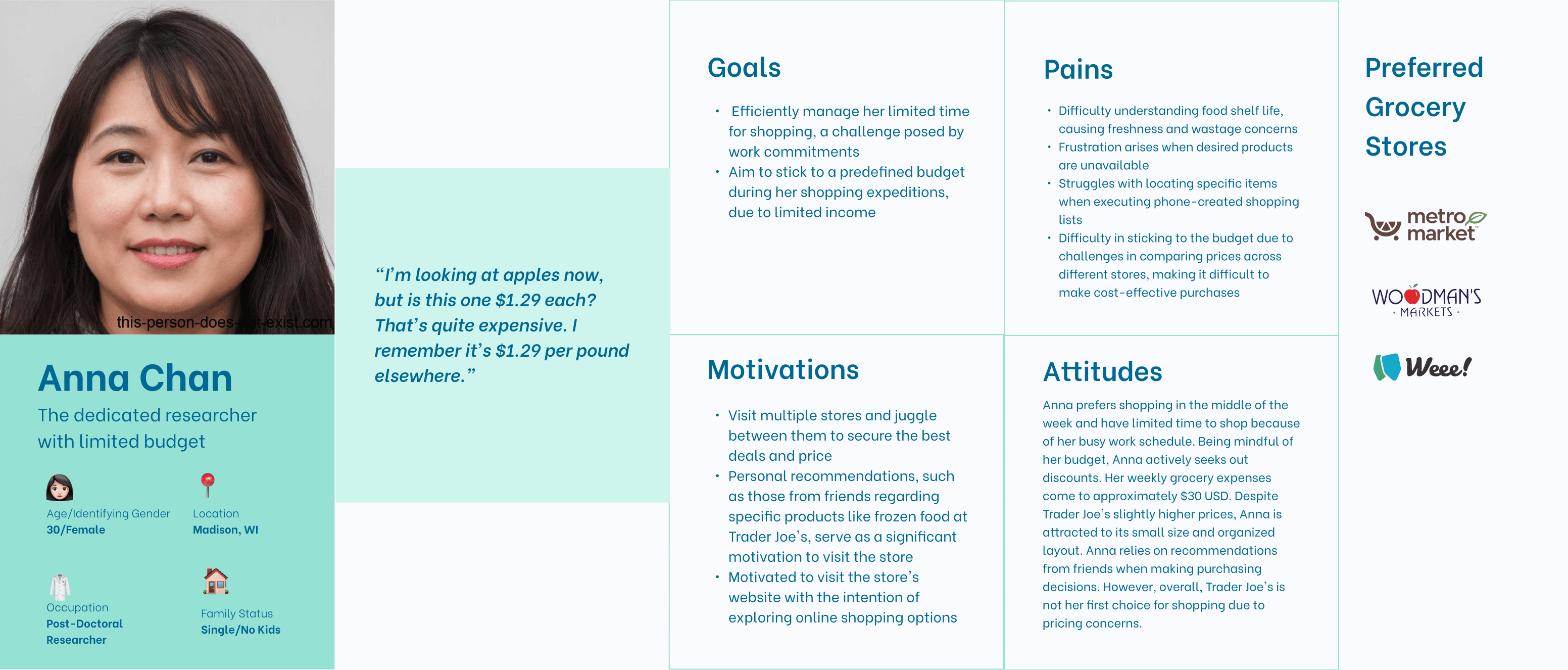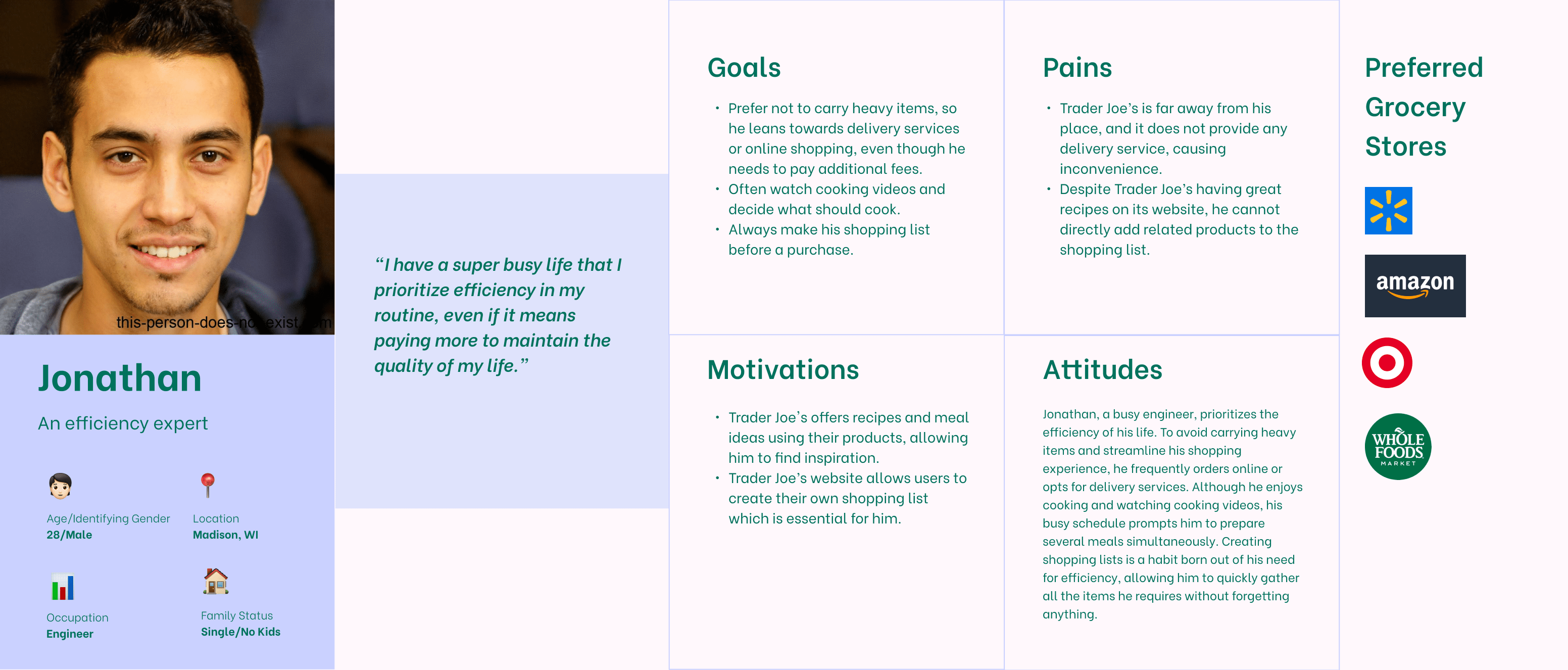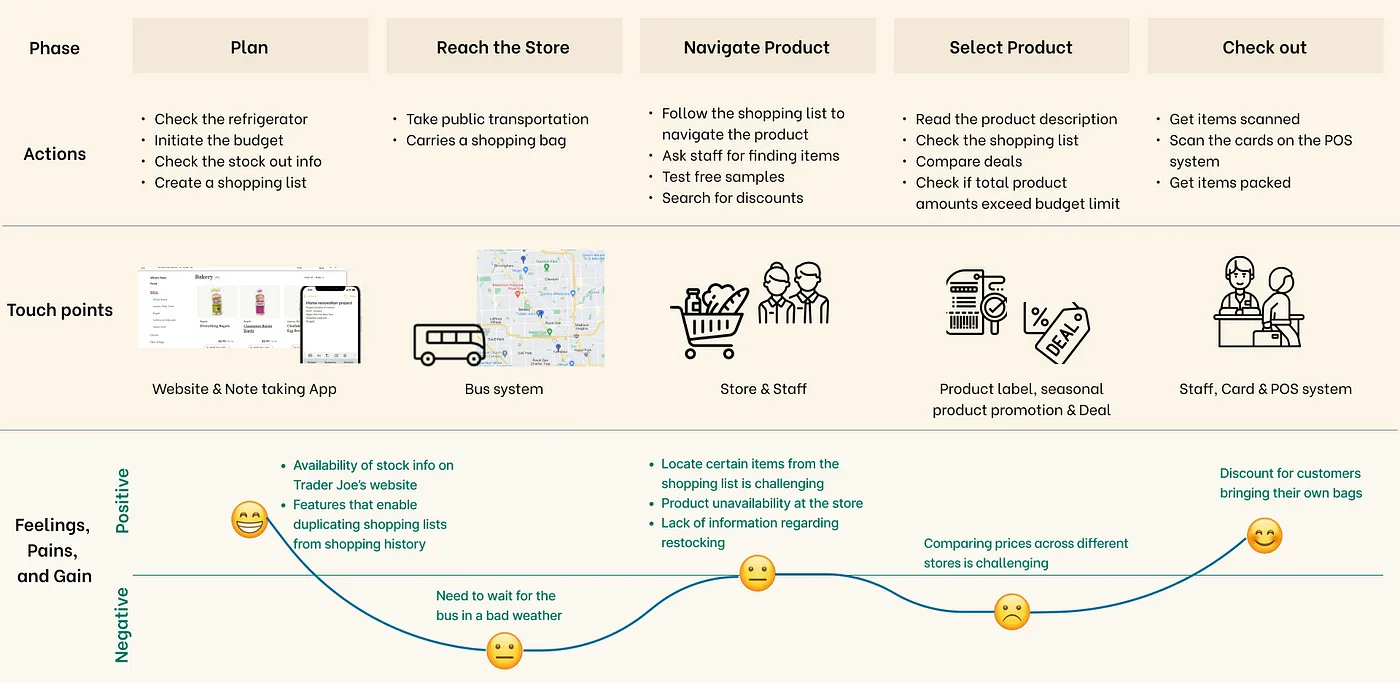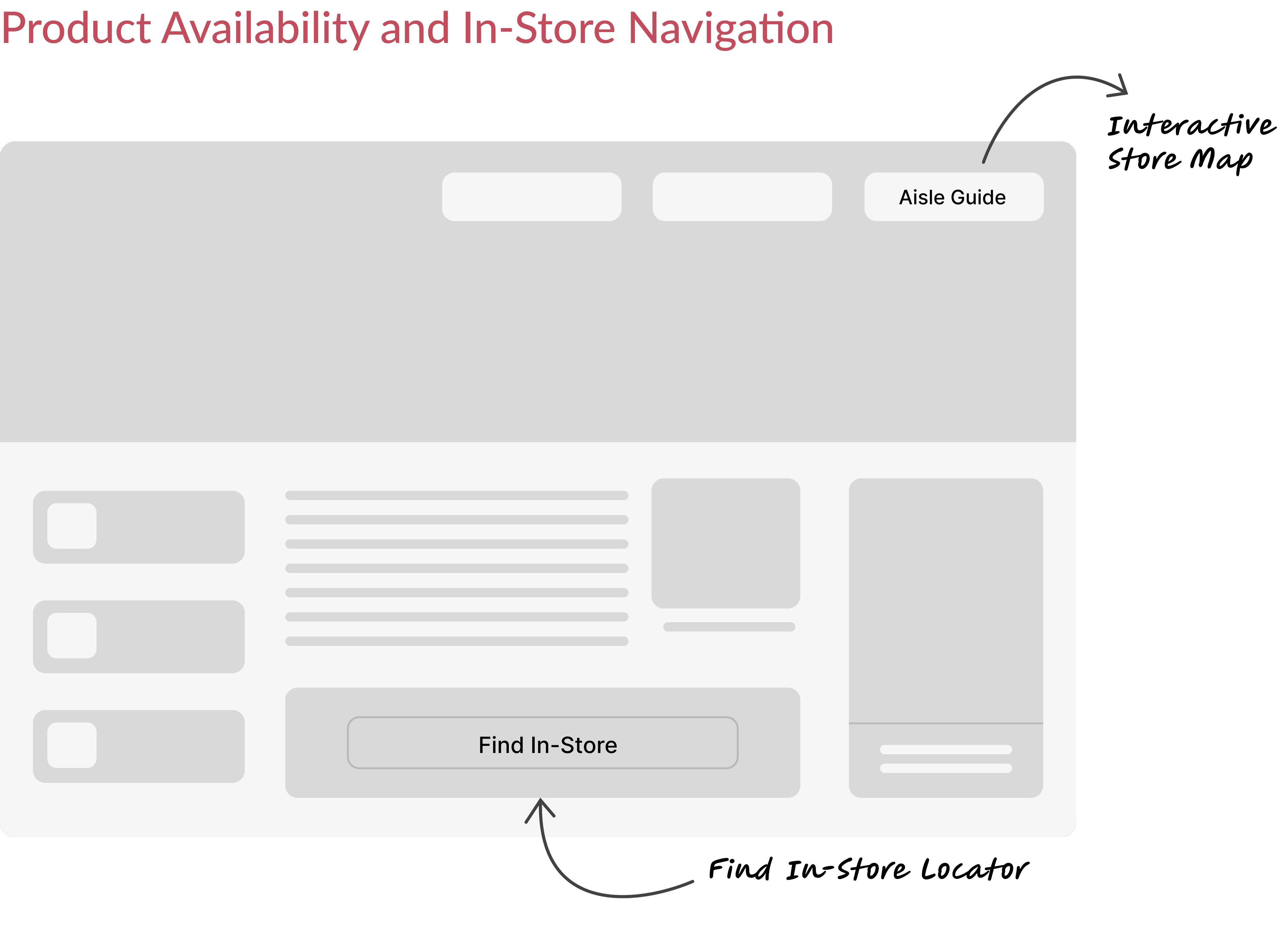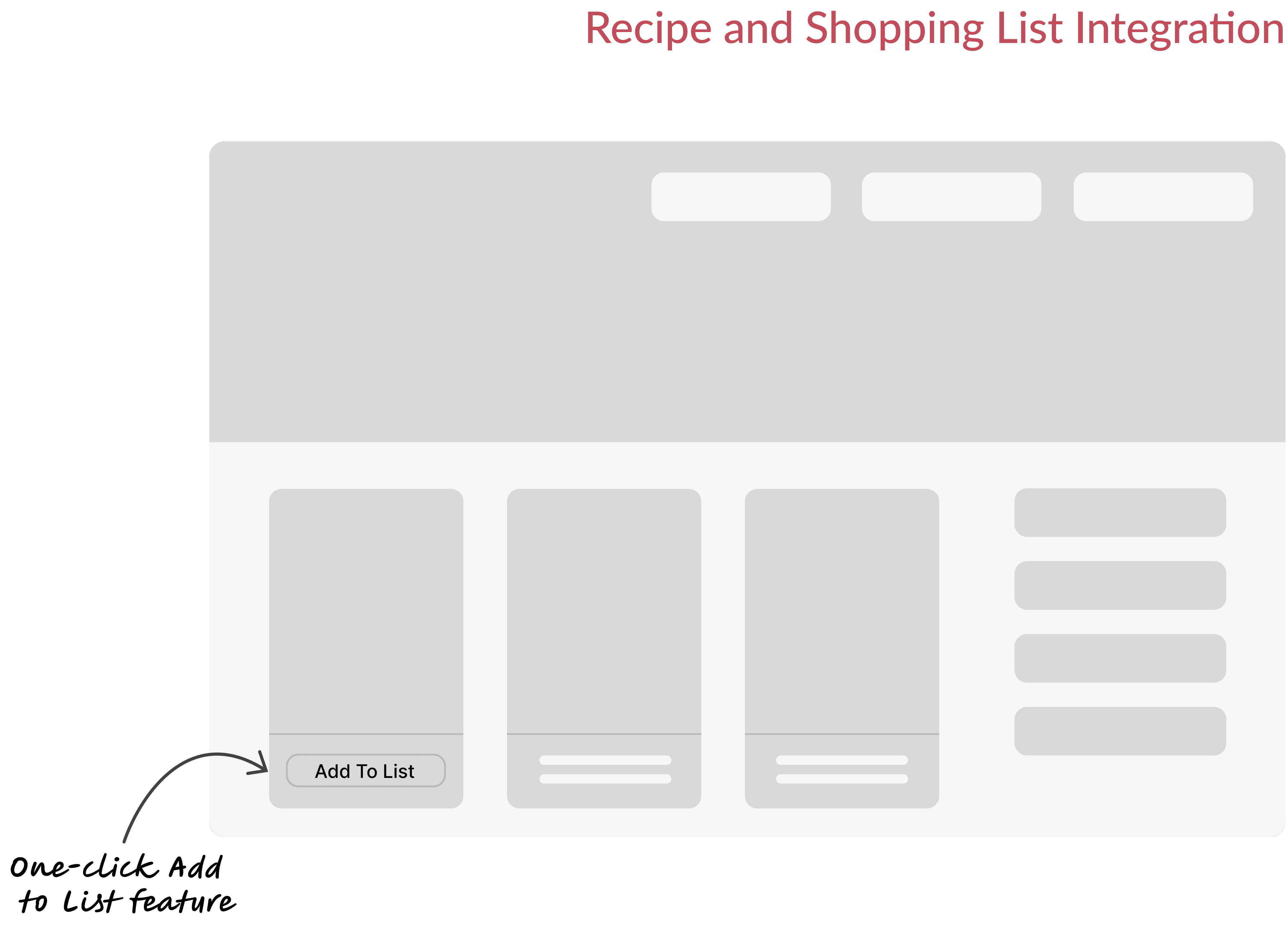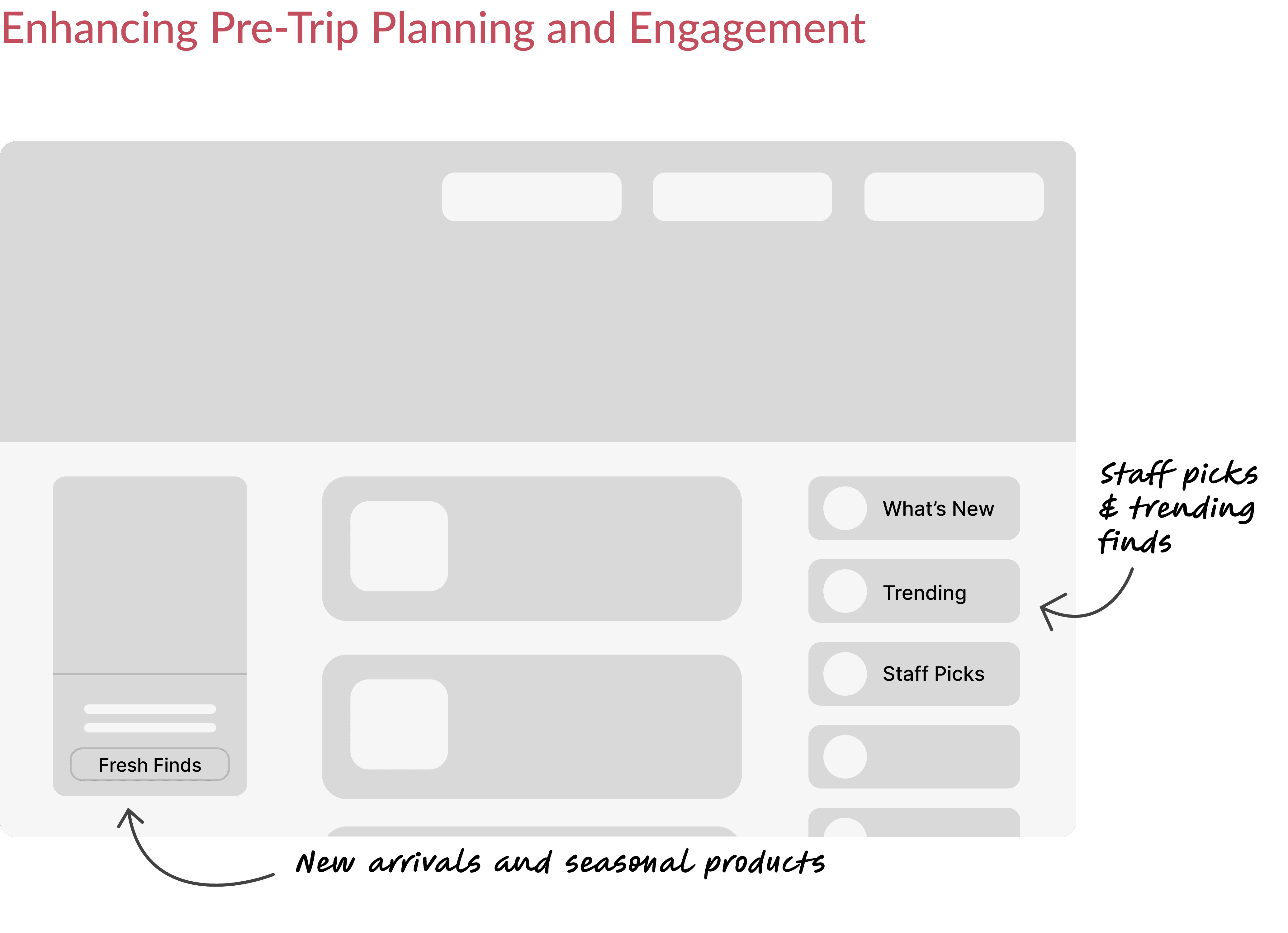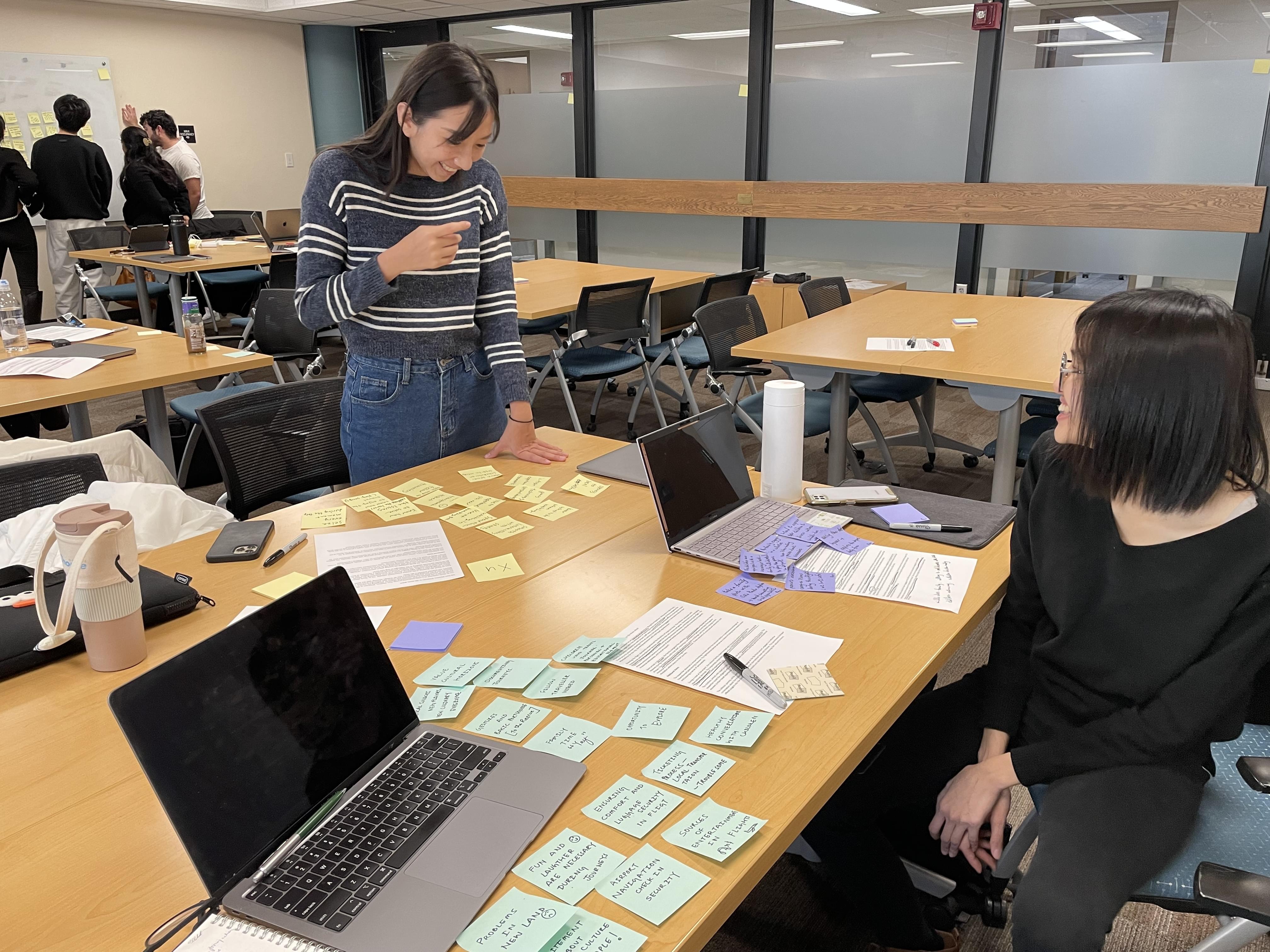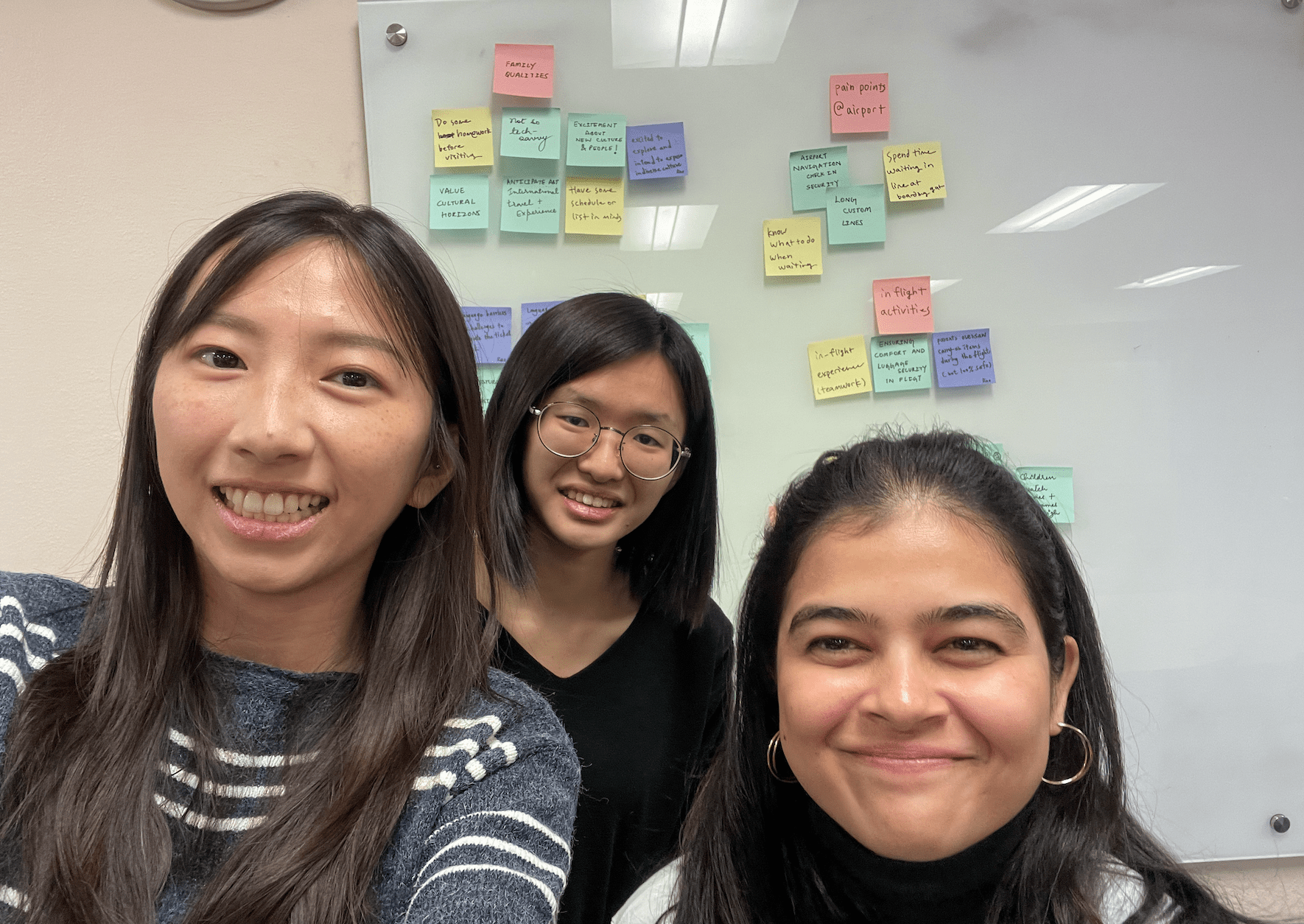Trader Joe's - User Research Plan
A user research study to understand users pain-points and enhance their grocery shopping experience at Trader Joe's.
Process Highlight
Research challenge and responsibilities overview
Challenge
Find ways to boost user engagement and enhance customer's shopping experience at Trader Joe's.
Opportunity
Plan and conduct a user research to identify pain points in the retail shopping experience of Trader Joe's and draw insights to implement improved features.
Background
This case study was a student group project for the User Experience Design I course at the University of Wisconsin, Madison. For this assignment, our team was tasked with selecting an organization or service and then performing a comprehensive UX research study on it.
Timeline
Oct 2023 - Dec 2023
My Role
UX Researcher
Disciplines
User Experience Research
Qualitative Research
Data Analysis
Team
Aatisha Cyrill
Tsai Yi Lin (Maggie)
Fu-Yi Hsieh (Esther)
Tools
Figma
Miro
Qualtrics
Overview
Understanding the company and its goals.
Founded in 1967 by Joe Coulombe as a humble Los Angeles convenience store chain, Trader Joe's has since evolved into a nationally beloved grocery destination. Renowned for its unique private-label offerings, Trader Joe's has cultivated a devoted following by combining high-quality, affordable products with a warm, whimsical shopping experience. Recognizing the brand's rich history and unwavering commitment to customer delight is essential for evaluating its digital presence, ensuring that any user-focused improvements honor Trader Joe's distinct charm and approachable ethos.
Problem
There is a disconnect
Unlike its competitors, Trader Joe's does not offer e-commerce or online inventory tracking, making it difficult for shoppers to plan purchases, locate specific items, or stay updated on seasonal offerings.
The challenge is to explore digital enhancements that support, rather than replace, Trader Joe's in-store experience.
The Research Approach
Objectives and Scope
Clarifying Business Context
Project Rationale
Research Goals
Plan and Conduct Research
Competitor Analysis
Target Population
Research Methodology
Synthesis and Prioritization
Insight Generation Process
Research Findings
Affinity Diagram
User Persona
User Journey Map
Generate Recommendations
How Might We
Design Recommendations
Reflection
Learnings
Next Steps
Objectives and Scope
Clarifying Business Context
When we began this project, we recognized that Trader Joe's has a uniquely loyal community and a strong reputation for providing an engaging, in-store “treasure hunt” experience. We learned that their strategy hinges on:
- Curated product lines and a distinctive brand personality
- Small store footprints, fostering personal connections between crew members and customers
- No e-commerce, which helps keep costs low and encourages face-to-face interactions

"...It's that experience of being inside the four walls of Trader Joe's that makes Trader Joe's what it is. That experience would not be the same if you were trying to order something from a website that showed you the products you already know about."
Tara Miller
VP Marketing, Trader Joe's
Objectives and Scope
Project Rationale
During our preliminary research, we noticed that customers often experience common pain points while shopping at Trader Joe's. While a sense of discovery is part of the brand's charm, we suspected that some challenges could be eased through carefully designed online solutions.
Because Trader Joe's already has a website, we saw an opportunity to strengthen the in-store experience by introducing or refining digital touchpoints. Our goal wasn't to push for an e-commerce platform, but rather to highlight information that might streamline or enhance the in-person visit.
Plan and Conduct Research
Competitor Analysis
As a team, we wanted to explore grocery brands that prioritize brick-and-mortar experiences and community engagement over e-commerce. Hence, we conducted a comprehensive competitor analysis on three brands: Aldi, Sprouts, and Wegmans to understand what each one offers and identify key lessons Trader Joe's could draw upon:
What can Trader Joe's learn from its competitors?
- Curated Selections and Exclusives: Unique, private-label offerings define a store's identity. Trader Joe's can keep rotating new products to maintain its “treasure hunt” appeal.
- In-Store Atmospheres: Store layout and ambience reinforce brand values. Trader Joe's may refine its “treasure hunt” approach with clever signage, sampling stations, or themed sections.
- Community and Personal Connection: Friendly staff, local events, and sampling build loyalty. Trader Joe's could offer mini cooking demos or recipe boards to enhance the sense of discovery and fun.
"...these insights reaffirmed that Trader Joe's can remain offline-first while still refining the in-store experience."
Plan and Conduct Research
Target Population
We recruited individuals who met the following criteria for research participation:
Plan and Conduct Research
Research Methodology
To gain a comprehensive understanding of user experiences, we employed a mixed-method approach, incorporating user interviews, contextual inquiries, and surveys.
Synthesis and Prioritization
Insight Generation Process
After conducting our research, we gathered a large volume of data points. To streamline our analysis and extract actionable insights, we followed these three steps:
Synthesis and Prioritization
User Persona
We created three personas to represent three different categories of users based on their budget preferences and shopping choices. This helped us understand and visualize the pains and motivations of different sets of users.
Synthesis and Prioritization
User Journey Map
We created the user journey based on Anna Chan's persona, considering that the majority of research participants align with her characteristics (limited budget and doesn't prefer Trader Joe's website). We found out that the user faces the most challenge in reaching the store and through product navigation and selection.
Generate Recommendations
How Might We
We formulated How Might We (HMW) statements to explore opportunities for enhancing Trader Joe's in-store shopping experience through digital improvements while staying true to its brick-and-mortar-first strategy:
How might we help customers easily find product locations and availability without disrupting the in-store “treasure hunt” experience?
How might we streamline the in-store shopping experience to make product discovery and navigation more efficient?
How might we enhance the Trader Joe's website to increase engagement and encourage pre-trip planning?
How might we integrate recipes with shopping lists to improve meal planning and grocery efficiency?
Generate Recommendations
Design Recommendations
We translated our research findings and HMW statements into actionable design recommendations that enhance Trader Joe's in-store shopping experience while leveraging digital tools strategically. These recommendations maintain the brand's playful, discovery-driven shopping culture and do not introduce traditional e-commerce.
A Find In-Store locator on the Trader Joe's website
- 64% of survey respondents wanted to check product stock before visiting the store.
- A simple tool that shows whether a product is available at a nearby location.
- Exact inventory counts are not shown to maintain flexibility.
Interactive store maps
- 40% of the participants struggled with in-store navigation.
- A digital aisle guide that highlights where popular or seasonal items are placed.
- Preserves the treasure hunt feel while improving efficiency.
Adding ingredients to shopping list from recipes
- Users struggled to connect recipes with products, with recipe helpfulness scoring only 2.20/5 in surveys.
- Customers can click a button "Add to List" on a recipe page.
- It automatically generates a shopping list of ingredients available at Trader Joe's.
“Fresh Finds” and “What's New” sections on the website
- Many customers only discover new products in-store, leading to missed engagement opportunities.
- The section features new, seasonal, or limited-time items.
- It helps generate excitement and encourage users to store visits.
Personalized Product Collections
- Users appreciate Trader Joe's curated selections, and a personalized touch could encourage browsing.
- The website could showcase themed product collections like "Staff Picks" or "Trending Items."
Reflection
Learnings
Working as a team of three, we navigated user research, synthesis, and strategic design recommendations to explore how Trader Joe's could enhance its in-store experience through digital solutions. Throughout this project, we gained valuable insights into user behavior, brand constraints, and the intersection of physical and digital retail. The most insightful thing to learn was that research driven design strengthens decision making. Here are my key takeaways from this experience:
- Collaboration Enhances Design Thinking: Working in a team reinforced the value of collaborative brainstorming, critique, and iteration. I learnt that great design isn't created in isolation, it's built through shared knowledge and feedback.
- Designing Without Bias: At the start, we had our own preconceptions about digital retail solutions. However, through user interviews and contextual inquiry, we quickly learned that not all digital enhancements need to be transactional. Sometimes, the best design decisions are about removing friction, not reinventing the experience.
- Balancing Business Constraints and User Needs: This project reinforced the importance of working within real-world limitations. Understanding operational costs, brand values, and business models was just as important as understanding user pain points.
Reflection
Next Steps
Next, we aim to validate our recommendations with Trader Joe's stakeholders, gathering insights from store managers and marketing teams to refine feasibility. We will prototype key features like the Find In-Store tool, store map, and recipe-shopping list integration, conducting usability testing with shoppers to measure their impact. A pilot implementation of the "What's New" feature will help us track user engagement via Google Analytics and in-store feedback.


